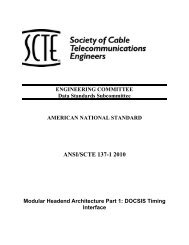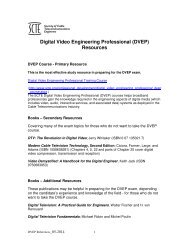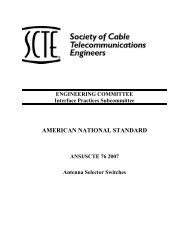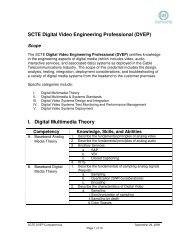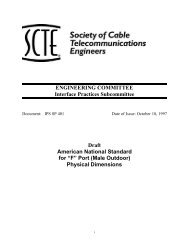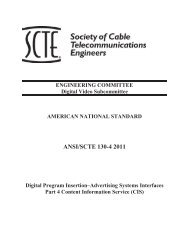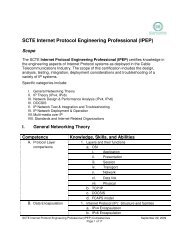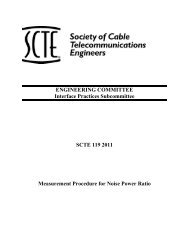ANSI/SCTE 16 2001R2007
ANSI/SCTE 16 2001R2007
ANSI/SCTE 16 2001R2007
Create successful ePaper yourself
Turn your PDF publications into a flip-book with our unique Google optimized e-Paper software.
Appendix 1 – Hum Modulation Derivation<br />
The equation for a TV sinewave amplitude modulated carrier is:<br />
y(t) = B[1 − (k / 2)(1 + cosω m t)]cosω<br />
c<br />
t<br />
(A -1)<br />
where B is the peak amplitude of the RF carrier and k is the modulation factor which is equal to:<br />
M pk−pk<br />
k = , k ≤ 1<br />
B<br />
and k is related to the conventional AM modulation index by the equation:<br />
(A - 2)<br />
k =<br />
2m<br />
( 1+<br />
m)<br />
where m is the conventional AM modulation index.<br />
If the peak-to-peak amplitude variation in time is kB, and this amplitude variation is considered<br />
to be hum modulation, hum is defined as.<br />
AM Mod(dB) = 20Log =<br />
B<br />
( kB ) 20Log( k) (A<br />
Hum modulation is simply a measurement of k, which is the ratio of the peak-to-peak hum on the<br />
carrier to the peak of the RF carrier (B).<br />
- 3)<br />
k =<br />
Hum<br />
B<br />
pk−pk<br />
(A - 4)<br />
Figure 2 shows a graphical representation of hum modulation using a continuous wave (CW)<br />
carrier as an example.<br />
Hum pk-pk<br />
V peak (Peak Voltage of RF Carrier)<br />
Carrier Voltage<br />
Time<br />
Figure 2<br />
11



